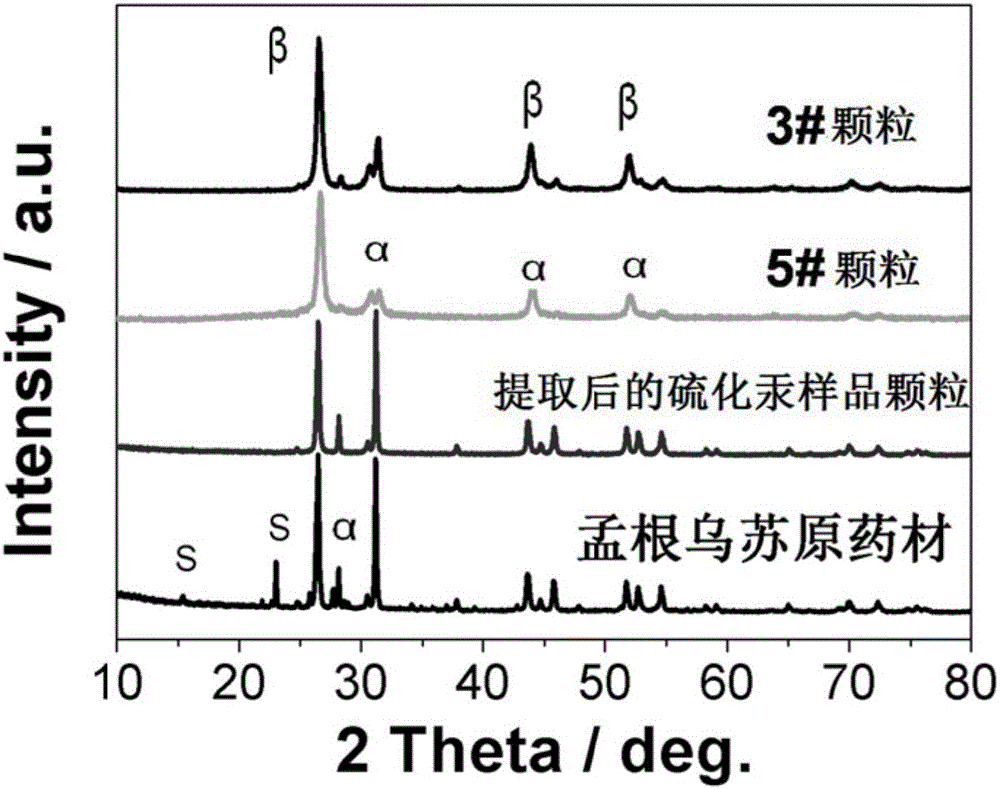Method for extracting and separating mercury sulfide nanoparticles in Mongolian medicine Menggenwusu
A kind of Menggen Wusu medium and nanoparticle technology, applied in chemical instruments and methods, nanotechnology, mercury compounds, etc., to achieve the effect of simple method, stable composition and easy standardization
- Summary
- Abstract
- Description
- Claims
- Application Information
AI Technical Summary
Problems solved by technology
Method used
Image
Examples
Embodiment 1
[0039] Step 1, extraction of mercury sulfide sample particles:
[0040] Weigh 2g of Menggenwusu powder, wrap it with filter paper, and put it into a Soxhlet extractor. 150ml of xylene was placed in a round-bottomed flask, heated to reflux at 150°C for 6h, and after natural cooling, a mercury sulfide sample was obtained in the Soxhlet extractor. The mercuric sulfide sample was taken out, placed in a fume hood for 15 hours to volatilize the xylene in the mercuric sulfide sample, then the mercuric sulfide sample was placed in a vacuum oven, and dried at 50° C. for 48 hours to obtain the mercuric sulfide sample particles. Store in a dry box for later use. The free sulfur in the sample is dissolved in xylene, and yellow sulfur crystals can be obtained after the xylene is recovered by distillation under reduced pressure.
[0041] Step 2, differential separation of mercury sulfide micro-nano particles:
[0042] Step 2.1, take 2g of mercuric sulfide sample particles, disperse the m...
Embodiment 2
[0053] Step 1, extraction of mercury sulfide sample particles:
[0054] Weigh 1g of Menggenwusu powder, wrap it with filter paper, and put it into a Soxhlet extractor. 100ml of carbon tetrachloride was placed in a round-bottomed flask, heated to reflux at 100°C for 4h, and after natural cooling, a mercury sulfide sample was obtained in the Soxhlet extractor. Take out the mercury sulfide sample, place it in a fume hood for 10 hours to volatilize the carbon tetrachloride in the mercury sulfide sample, then place the mercury sulfide sample in a vacuum oven, and dry it for 48 hours at 50°C to obtain a mercury sulfide sample Granules are placed in a dry box for later use. The free sulfur in the sample is dissolved in carbon tetrachloride, and yellow sulfur crystals can be obtained after carbon tetrachloride is recovered by distillation under reduced pressure.
[0055] Step 2, differential separation of mercury sulfide micro-nano particles:
[0056] Step 2.1, weigh 1g of mercuric...
Embodiment 3
[0065] Step 1, extraction of mercury sulfide sample particles:
[0066] Weigh 3g of Menggenwusu powder, wrap it with filter paper, and put it into a Soxhlet extractor. 180ml of benzene was placed in a round bottom flask, heated to reflux at 120°C for 8h, and after natural cooling, a mercury sulfide sample was obtained in the Soxhlet extractor. Take out the mercuric sulfide sample, place it in a fume hood for 18 hours to volatilize the benzene in the mercuric sulfide sample, then place the mercuric sulfide sample in a vacuum oven, and dry it at 50°C for 48 hours to obtain the mercuric sulfide sample particles, put Store in a dry box for later use. The free sulfur in the sample is dissolved in benzene, and yellow sulfur crystals can be obtained after vacuum distillation and recovery of benzene.
[0067] Step 2, differential separation of mercury sulfide micro-nano particles:
[0068] Step 2.1, weigh 3g of mercuric sulfide sample particles, disperse the mercuric sulfide sample...
PUM
| Property | Measurement | Unit |
|---|---|---|
| concentration | aaaaa | aaaaa |
| particle size | aaaaa | aaaaa |
| particle diameter | aaaaa | aaaaa |
Abstract
Description
Claims
Application Information
 Login to View More
Login to View More - R&D
- Intellectual Property
- Life Sciences
- Materials
- Tech Scout
- Unparalleled Data Quality
- Higher Quality Content
- 60% Fewer Hallucinations
Browse by: Latest US Patents, China's latest patents, Technical Efficacy Thesaurus, Application Domain, Technology Topic, Popular Technical Reports.
© 2025 PatSnap. All rights reserved.Legal|Privacy policy|Modern Slavery Act Transparency Statement|Sitemap|About US| Contact US: help@patsnap.com


